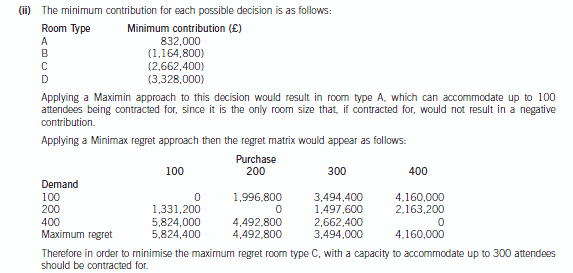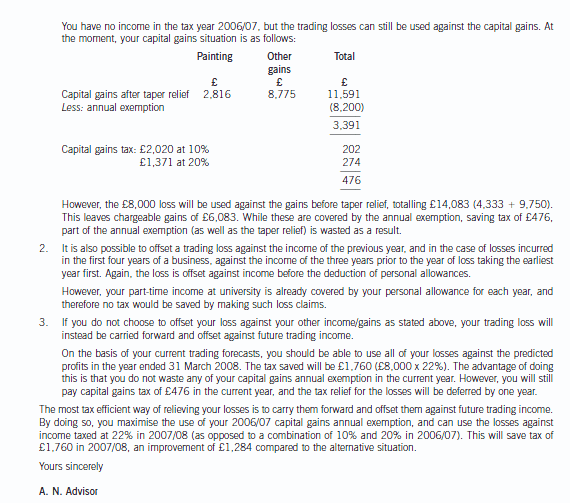ACCA考试F1考试试题练习及答案(4)
发布时间:2020-08-16
备考ACCA考试,好的学习方法很重要,但是练习也很重要,下面51题库考试学习网就给大家分享一些,ACCA考试F1考试试题,备考的小伙伴赶紧来练练手吧。
1. Alf Sparks is a
manager of a small team designing and building a new management information
system. The various levels of management that will be using the system will all
have different information requirements but the qualities of good information
are the same at each level. He is describing these qualities to his team.
Which of the following would be included in
his explanation?
(i) Comprehensive
(ii) Relevant
(iii) Accurate
(iv) Authoritative
A (i), (ii) and (iii)
B (ii), (iii) and (iv)
C (i), (ii) and (iv)
D (i), (iii) and (iv)
答案:B
2. External
auditors may place reliance on internal auditors\' work.
Is this statement correct?
A External auditors need to assess the work
of internal audit first
B Internal auditors are not independent and
so cannot be relied upon
C Yes, always
答案:A
3.Which of the following costs, which might
be incurred before or during the development of an
information system, are capital costs?
(i) Hardware purchase costs
(ii) Costs of testing the system
(iii) Software purchase costs
(iv) Installation costs
A (i), (ii) and (iii)
B (i), (ii) and (iv)
C (ii), (iii) and (iv)
D (i), (iii) and (iv)
答案:D
4. Who appoints
external auditors?
A Chairman
B Finance director
C Shareholders
答案:C
5. Control over cash receipts will
concentrate on three main areas.
Receipts must be ____promptly
The record of receipts must be______
The loss of receipts through theft or
accident must be______A Banked, complete, prevented
B Counted, accurate, reported
C Banked, accurate, avoided
D Reported, accurate, prevented
答案:A
以上是本次51题库考试学习网分享给大家的ACCA考试试题,备考的小伙伴抓紧时间练习一下吧。欲了解更多关于ACCA考试的试题,敬请关注51题库考试学习网!
下面小编为大家准备了 ACCA考试 的相关考题,供大家学习参考。
(ii) Determine whether your decision in (b)(i) would change if you were to use the Maximin and Minimax
regret decision criteria. Your answer should be supported by relevant workings. (6 marks)

(ii) Write a letter to Donald advising him on the most tax efficient manner in which he can relieve the loss
incurred in the year to 31 March 2007. Your letter should briefly outline the types of loss relief available
and explain their relative merits in Donald’s situation. Assume that Donald will have no source of income
other than the business in the year of assessment 2006/07 and that any income he earned on a parttime
basis while at university was always less than his annual personal allowance. (9 marks)
Assume that the corporation tax rates and allowances for the financial year 2004 and the income tax rates
and allowances for 2004/05 apply throughout this question.
Relevant retail price index figures are:
January 1998 159·5
April 1998 162·6
(ii) [Donald’s address] [Firm’s address]
Dear Donald [Date]
I understand that you have incurred a tax loss in your first year of trading. The following options are available in respect
of this loss.
1. The first option is to use the trading loss against other forms of income in the same year. If such a claim is made,
losses are offset against income before personal allowances.
Any excess loss can still be offset against capital gains of the year. However, any offset against capital gains is
before both taper relief and annual exemptions.

4 Hogg Products Company (HPC), based in a developing country, was recently wholly acquired by American Overseas
Investments (AOI), a North American holding company. The new owners took the opportunity to completely review
HPC’s management, culture and systems. One of the first things that AOI questioned was HPC’s longstanding
corporate code of ethics.
The board of AOI said that it had a general code of ethics that HPC, as an AOI subsidiary, should adopt. Simon Hogg,
the chief executive of HPC, disagreed however, and explained why HPC should retain its existing code. He said that
HPC had adopted its code of ethics in its home country which was often criticised for its unethical business behaviour.
Some other companies in the country were criticised for their ‘sweat shop’ conditions. HPC’s adoption of its code of
ethics, however, meant that it could always obtain orders from European customers on the guarantee that products
were made ethically and in compliance with its own highly regarded code of ethics. Mr Hogg explained that HPC had
an outstanding ethical reputation both locally and internationally and that reputation could be threatened if it was
forced to replace its existing code of ethics with AOI’s more general code.
When Ed Tanner, a senior director from AOI’s head office, visited Mr Hogg after the acquisition, he was shown HPC’s
operation in action. Mr Hogg pointed out that unlike some other employers in the industry, HPC didn’t employ child
labour. Mr Hogg explained that although it was allowed by law in the country, it was forbidden by HPC’s code of
ethics. Mr Hogg also explained that in his view, employing child labour was always ethically wrong. Mr Tanner asked
whether the money that children earned by working in the relatively safe conditions at HPC was an important source
of income for their families. Mr Hogg said that the money was important to them but even so, it was still wrong to
employ children, as it was exploitative and interfered with their education. He also said that it would alienate the
European customers who bought from HPC partly on the basis of the terms of its code of ethics.
Required:
(a) Describe the purposes and typical contents of a corporate code of ethics. (9 marks)
(a) Purposes of codes of ethics
To convey the ethical values of the company to interested audiences including employees, customers, communities and
shareholders.
To control unethical practice within the organisation by placing limits on behaviour and prescribing behaviour in given
situations.
To be a stimulant to improved ethical behaviour in the organisation by insisting on full compliance with the code.
[Tutorial note: other purposes, if relevant, will be rewarded]
Contents of a corporate code of ethics
The typical contents of a corporate code of ethics are as follows:
Values of the company. This might include notes on the strategic purpose of the organisation and any underlying beliefs,
values, assumptions or principles. Values may be expressed in terms of social and environmental perspectives, and
expressions of intent regarding compliance with best practice, etc.
Shareholders and suppliers of finance. In particular, how the company views the importance of sources of finances, how it
intends to communicate with them and any indications of how they will be treated in terms of transparency, truthfulness and
honesty.
Employees. Policies towards employees, which might include equal opportunities policies, training and development,
recruitment, retention and removal of staff. In the case of HPC, the policy on child labour will be covered by this part of the
code of ethics.
Customers. How the company intends to treat its customers, typically in terms of policy of customer satisfaction, product mix,
product quality, product information and complaints procedure.
Supply chain/suppliers. This is becoming an increasingly important part of ethical behaviour as stakeholders scrutinise where
and how companies source their products (e.g. farming practice, GM foods, fair trade issues, etc). Ethical policy on supply
chain might include undertakings to buy from certain approved suppliers only, to buy only above a certain level of quality, to
engage constructively with suppliers (e.g. for product development purposes) or not to buy from suppliers who do not meet
with their own ethical standards.
Community and wider society. This section concerns the manner in which the company aims to relate to a range of
stakeholders with whom it does not have a direct economic relationship (e.g. neighbours, opinion formers, pressure groups,
etc). It might include undertakings on consultation, ‘listening’, seeking consent, partnership arrangements (e.g. in community
relationships with local schools) and similar.
[Tutorial note: up to six points to be identified and described but similar valid general contents are acceptable]
声明:本文内容由互联网用户自发贡献自行上传,本网站不拥有所有权,未作人工编辑处理,也不承担相关法律责任。如果您发现有涉嫌版权的内容,欢迎发送邮件至:contact@51tk.com 进行举报,并提供相关证据,工作人员会在5个工作日内联系你,一经查实,本站将立刻删除涉嫌侵权内容。
- 2020-08-16
- 2020-08-16
- 2020-08-16
- 2020-08-16
- 2020-08-16
- 2020-08-16
- 2020-08-16
- 2020-08-16
- 2020-08-16
- 2020-08-16
- 2020-08-16
- 2020-08-16
- 2020-08-16
- 2020-08-16
- 2020-08-16
- 2020-08-16
- 2020-08-16
- 2020-08-16
- 2020-08-16
- 2020-08-16
- 2020-08-16
- 2020-08-16
- 2020-08-16
- 2020-08-16
- 2020-08-16
- 2020-08-16
- 2020-08-16
- 2020-08-16
- 2020-08-16
- 2020-08-16